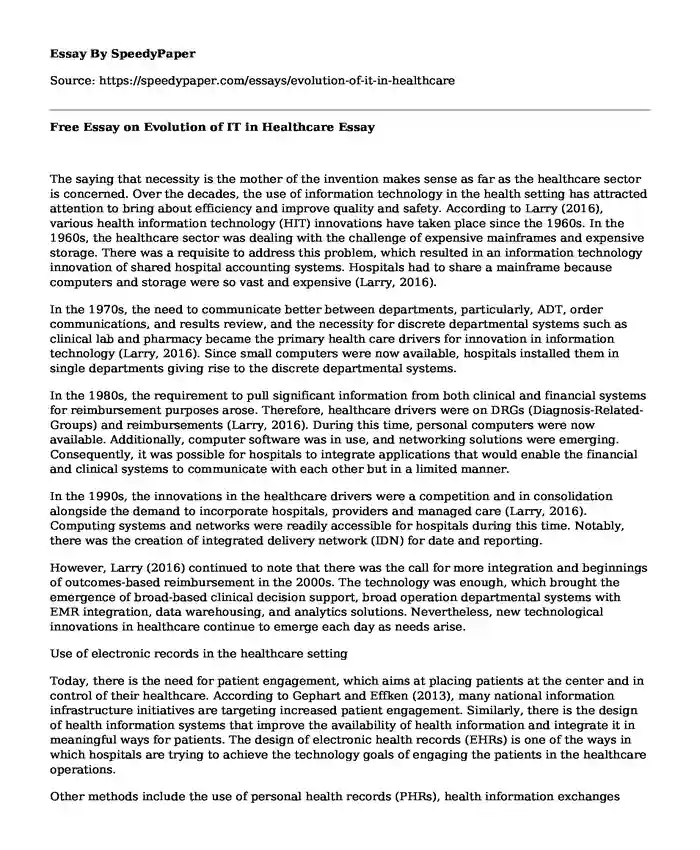
| Type of paper: | Essay |
| Categories: | Health and Social Care Information technologies |
| Pages: | 3 |
| Wordcount: | 585 words |
The saying that necessity is the mother of the invention makes sense as far as the healthcare sector is concerned. Over the decades, the use of information technology in the health setting has attracted attention to bring about efficiency and improve quality and safety. According to Larry (2016), various health information technology (HIT) innovations have taken place since the 1960s. In the 1960s, the healthcare sector was dealing with the challenge of expensive mainframes and expensive storage. There was a requisite to address this problem, which resulted in an information technology innovation of shared hospital accounting systems. Hospitals had to share a mainframe because computers and storage were so vast and expensive (Larry, 2016).
In the 1970s, the need to communicate better between departments, particularly, ADT, order communications, and results review, and the necessity for discrete departmental systems such as clinical lab and pharmacy became the primary health care drivers for innovation in information technology (Larry, 2016). Since small computers were now available, hospitals installed them in single departments giving rise to the discrete departmental systems.
In the 1980s, the requirement to pull significant information from both clinical and financial systems for reimbursement purposes arose. Therefore, healthcare drivers were on DRGs (Diagnosis-Related-Groups) and reimbursements (Larry, 2016). During this time, personal computers were now available. Additionally, computer software was in use, and networking solutions were emerging. Consequently, it was possible for hospitals to integrate applications that would enable the financial and clinical systems to communicate with each other but in a limited manner.
In the 1990s, the innovations in the healthcare drivers were a competition and in consolidation alongside the demand to incorporate hospitals, providers and managed care (Larry, 2016). Computing systems and networks were readily accessible for hospitals during this time. Notably, there was the creation of integrated delivery network (IDN) for date and reporting.
However, Larry (2016) continued to note that there was the call for more integration and beginnings of outcomes-based reimbursement in the 2000s. The technology was enough, which brought the emergence of broad-based clinical decision support, broad operation departmental systems with EMR integration, data warehousing, and analytics solutions. Nevertheless, new technological innovations in healthcare continue to emerge each day as needs arise.
Use of electronic records in the healthcare setting
Today, there is the need for patient engagement, which aims at placing patients at the center and in control of their healthcare. According to Gephart and Effken (2013), many national information infrastructure initiatives are targeting increased patient engagement. Similarly, there is the design of health information systems that improve the availability of health information and integrate it in meaningful ways for patients. The design of electronic health records (EHRs) is one of the ways in which hospitals are trying to achieve the technology goals of engaging the patients in the healthcare operations.
Other methods include the use of personal health records (PHRs), health information exchanges (HIEs) and patient portals (Gephart & Effken, 2013). The use of EHRs helps in the centralization of patients information leading to efficiency in the health sector. Furthermore, healthcare providers get access to critical patient information from multiple providers all the time. It is paramount to note that, patients are entitled to an electronically generated copy of the record of their encounters with vendors. Moreover, sharing provider-generated data with patients promotes patient engagement and accountability (Gephart & Effken, 2013).
References
Gephart, S. M., & Effken, J. A. (2013). Using health information technology to engage patients in their care. Online Journal of Nursing Informatics, 17(3).Larry, G. (2016), Healthcare Information Systems: A Look at the Past, Present, and Future.
Cite this page
Free Essay on Evolution of IT in Healthcare. (2019, Oct 28). Retrieved from https://speedypaper.com/essays/evolution-of-it-in-healthcare
Request Removal
If you are the original author of this essay and no longer wish to have it published on the SpeedyPaper website, please click below to request its removal:
- Free Essays with Persuasive Speeches about Donating Blood
- Free Essay about Attendance and Punctuality at School and Work
- Automotive Industry Research - Essay Sample
- International Political Economy - Free Essay
- Intermediate Sanction Essay Example
- How the Treaty of Versailles Led to WWII - Paper Sample
- Paper Sample: A Secluded Island of Victoria
Popular categories




